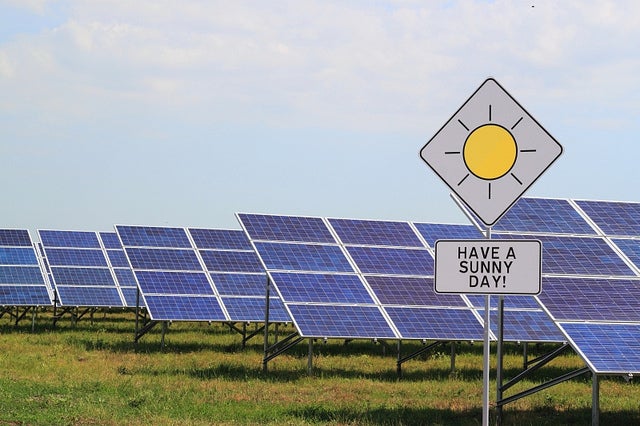 Ask most people what the Beatles and California have in common and they might very well be at a loss. However, the answer is pretty simple: they are both unabashed trendsetters in the face of resistance – the former in their musical style and the latter in its clean energy policies.
Ask most people what the Beatles and California have in common and they might very well be at a loss. However, the answer is pretty simple: they are both unabashed trendsetters in the face of resistance – the former in their musical style and the latter in its clean energy policies.
Not content with setting a Renewable Portfolio Standard that ends at 2020, Governor Jerry Brown and state legislators are pushing for the Golden State to get 50 percent of its energy from renewable resources by 2030.
To meet this ambitious target, California must build a system that is largely based on renewable electricity, like wind and solar. This is not an easy task. The primary reason? Sunshine and wind are only available at certain times of the day and can be variable during those times.
Traditionally, managers of the electricity grid have relied upon dirty “peaker” power plants – usually fossil fuel-fired and only needed a couple of days a year – to balance the grid during periods of variability or when electricity demand exceeds supply. But, in a world where 50 percent of our energy comes from renewable sources as a means to achieving a clean energy economy, we can’t rely on these dirty peaker plants to balance the variability of wind and solar.
Luckily, technology is available today that can help fill the gap of these peaker plants – and the California Public Utilities Commission (CPUC) is starting to embrace it.
This technology, also known as demand-side resources, is defined by the CPUC as:
- Energy efficiency
- Demand response, an energy conservation tool that pays customers to save energy when the grid is stressed
- Distributed generation, like rooftop solar PV
- Energy storage, including electric vehicle batteries
- Smart grid, which utilizes technologies like two way programmable thermostats, to gather energy use information to improve efficiency and enable other resources like demand response
- Water-energy measures, which address the inextricable effect of water use on energy use, and vice-versa
- Strategic electricity rate design, such as time-of-use pricing, a voluntary program that enables people to choose when they power up appliances based on electricity prices and make decisions that can both save them money and reduce harmful pollution
By encouraging customers to use energy more wisely through demand-side resources like these, utility companies can avoid the need to produce more energy as the state’s population increases. This will also cut down on infrastructure costs, as fewer power plants and transmission lines will need to be built, and those savings can be passed on to customers. Further, by leveraging the ability of electric vehicles to charge at times when there is an abundance of clean power available, as well as distributed generation, California will be able to use increasing amounts of renewable energy.
Currently, there are a number of these innovative, demand-side solutions available in California. In order to bring them together, the CPUC, under the direction of Commissioner Michel Florio, initiated a new proceeding to, “create a consistent regulatory framework for the guidance, planning, and evaluation of integrated demand side resource programs.”
EDF would like to make sure the CPUC advances the following outcomes, as stated in our formal comments:
- Ensure Californians are an integral part of the solution. Resources on the customer side of the meter should be given due consideration and incentivized by properly structured rates and ensuring these customer-side resources are properly valued.
- Target demand-side resources geographically. The CPUC should focus on the placement of demand-side resources where they will have the most benefit – i.e., in those areas hit hardest by air pollution. This will ensure communities historically and disproportionately burdened by dirty air benefit from these improvements.
- Consider how to link utility revenues to the outcomes California wants. Rather than allowing cost recovery as a matter of course, the CPUC should develop principles for a utility business model that rewards utilities and Californians for integrating cost-saving, well-targeted demand-side measures on both sides of the meter. Successful resources will be those that contribute to the reliable operation of the grid and advance state environmental goals, such as AB 32 (California’s Global Warming Solutions Act of 2006, a landmark piece of legislation that set an absolute, state-wide limit on greenhouse gas emissions) and the Renewable Portfolio Standard.
- Link closely with distribution and reliability planning. By requiring the consideration of demand-side resources in utility planning, the CPUC can help to defer or avoid the need for more costly or environmentally damaging investments.
This new effort by the CPUC is a terrific opportunity for more coordinated, cost-effective deployment of demand-side resources that can better address California’s energy needs, improve customer choice, and reduce carbon pollution from our energy system. It’s a chance to make real, lasting change in California. Similar to the transformative effect “Beatlemania” had on music and popular culture, California’s clean energy policies can transform how we make, move, and use electricity.
This post originally appeared on EDF’s California Dream 2.0 blog.
Photo credit: Activ Solar









